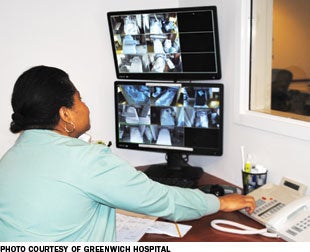Falls prevention program delivers promising results
 |
|---|
| A nurse assistant monitors patients who are at risk for falls. |
A combination of modern technology and old-fashioned personal attention is proving to be a winning formula in combating the vexing challenge of preventing patient falls.
While it's too soon to say with certainty, the indications are highly favorable that Greenwich (Conn.) Hospital has developed an effective falls prevention program that could serve as a model for other health care facilities.
The multilayered program includes 24-hour video surveillance of up to 14 patients who are identified at admission as being at risk for falling, usually because of age or unpredictable behavior, says Susan Brown, R.N., senior vice president of patient care services.
Two certified nurse assistants take turns about every two hours so that one is always watching the at-risk patients on video monitors and the second nurse assistant is making rounds to visit the patients in their rooms.
An important component of the program is use of an overhead call system to tell patients who are behaving in a manner that could lead to a fall to not continue to get up until a staff member can help them, Brown says. Another safeguard in the program includes the ability of the nurse assistant room monitor to activate a flashing strobe light that serves as a fall alert for the other nurse assistant and nearby staff to immediately check on the patient who may be at risk of falling, Brown adds.
As for the results, so far so good. After the first year of the program, during which 1,600 were admitted to the hospital's monitored rooms, there has been only one patient fall, a 20 percent reduction compared with that of prior years, she says.
Halfway through the second year, there has been one patient fall. "We're staying on track. You can't prevent every fall, but we've certainly decreased falls and increased safety," Brown says.
In addition, the hospital will save $250,000 annually by eliminating the previous ineffective system of patient sitters who watched patients at risk for falls on a one-to-one basis 24 hours a day in their rooms, she says.
"It is extremely successful," Brown says about the new program, which cost $52,000 to start up.
Greenwich's program is generating interest at other hospitals. Brown says after the hospital held a recent webinar on this program, several health care facilities contacted them about how they could implement it.
Between 700,000 and 1 million patients fall in U.S. hospitals each year, according to the Agency for Healthcare Research and Quality. The Joint Commission reports that the average increase in a hospital's operational costs for a serious fall-related injury is more than $13,000.




